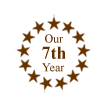.
Continued from product description
on Home Crafts' Page Five...
Historical
Background: Knitting needles are available in various
sizes (from 2mm to 9mm) and in many lengths -- from about 7 inches
for small needles up to about 15 inches for jumbo needles. Not
all knitting needles are straight! Some are circular and are
joined together by a flexible piece of wire or plastic. These
are used for knitting large tubular items without seams, such
as sweaters. Circular knitting needles made of nylon come in
lengths up to 36 inches, depending on the "size of the needle."
They are normally used in pairs. Knitting needles either have
a bob at one end or they are double pointed.
Pieces of knitted works that date back to the 7th century
have been located in Arabia. It is believed that sailors, soldiers,
and tradesmen spread this craft from the Middle East to Europe.
The first knitting guilds were set up in 1527 in Paris, France,
and were dominated by men. Women did the spinning and men did
the weaving and knitting. The art of knitting spread throughout
many European countries, and each country seemed to adopt its
own special emphasis. Southern Europe concentrated on church
work. France, Spain, and Italy specialized in fine, lacy stockings,
gloves, and knitted jackets, while German and Austrian knitters
utilized the wool available and became known for the their wall
hangings.
Knitting popularity continued to grow, and William Lee invented
the first knitting machine in 1589 when he realized that the
process of knitting could be done much faster. Knitting guilds
began to decline by the mid-1700s, but domestic hand knitting,
which had now been adopted by women, continued.
Alice Mores Earle states in her book, "Child Life in
Colonial Times": "Knitting was taught to little girls
as soon as they could hold needles. Girls four years of age could
knit stockings and mittens."
During the 19th-century wars, soldiers needed knitted items
to protect them from the cold so this need provided work for
knitters. Circulating libraries and women's magazines promoted
knitting. Knitters living in remote areas still practiced the
traditional patterns that were handed down by generations before
them. The Fair Isle sweater was one of these. The popularity
of the authentic Fair Isle hand knitted sweater began in 1920
and continues today.













